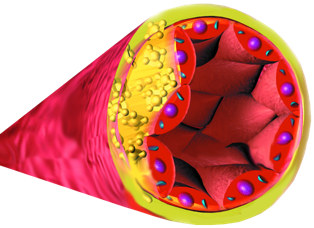- Have any questions? Contact us!
- info@dr-rath-foundation.org

Colorectal And Pancreatic Cancer Rates Up 10 Percent In Last 30 Years
October 24, 2019
Is The Stethoscope Dying? High-Tech Rivals Pose A Threat
October 25, 2019Understanding The Difference Between Clinical And Sub-Clinical Micronutrient Deficiencies

A variety of different micronutrients are required in order to maintain health and prevent disease. As the body is mostly unable to manufacture these substances itself, they need to be supplied from our food. When our daily diets contain an insufficient supply of micronutrients, disease can result. While clinical deficiency diseases such as scurvy are mostly rare in developed countries these days, many common health problems result from the existence of chronic sub-clinical deficiencies. As Dr. Rath’s groundbreaking Cellular Medicine research has shown, such deficiencies are the primary cause of today’s most common chronic diseases.
Orthodox medicine today has largely misunderstood the importance of addressing sub-clinical vitamin deficiencies. Dr. Albert Szent-György, the Hungarian scientist who won a Nobel prize in 1937 for his discovery of vitamin C, understood this very well. In a letter he sent to the two-time Nobel prizewinner Linus Pauling in 1970, Szent-György wrote the following:
 Albert Szent-György (1893-1986)
“Right from the beginning I felt that the medical profession misled the public. If you don’t take ascorbic acid [vitamin C] with your food you get scurvy, so the medical profession said that if you don’t get scurvy you are all right. I think that this is a very grave error. Scurvy is not the first sign of the deficiency but a premortal syndrome, and for full health you need much more, very much more. I am taking, myself, about 1 g [1000 mg] a day. This does not mean that this is really the optimum dose because we do not know what full health really means and how much ascorbic acid you need for it. What I can tell you is that one can take any amount of ascorbic acid without the least danger.” |
In this article we will look at four key clinical vitamin deficiency diseases. We will conclude by summarizing Dr. Rath’s revolutionary scientific discovery that sub-clinical deficiencies, as opposed to clinical deficiencies, are the primary cause of chronic diseases.
Beriberi – vitamin B1 (thiamine) deficiency disease
 A severe lack of vitamin B1 results in a disease known as beriberi. There are two types of beriberi, wet and dry. Wet beriberi affects the heart and blood vessels. Symptoms include shortness of breath, swelling of the lower legs, a rapid heart rate, and chest pain. In extreme cases wet beriberi can lead to heart failure. Dry beriberi affects the nervous system and causes symptoms such as vomiting, seizures, muscle weakness, and mental confusion. Both forms of the disease can be life-threatening if not treated in time.
A severe lack of vitamin B1 results in a disease known as beriberi. There are two types of beriberi, wet and dry. Wet beriberi affects the heart and blood vessels. Symptoms include shortness of breath, swelling of the lower legs, a rapid heart rate, and chest pain. In extreme cases wet beriberi can lead to heart failure. Dry beriberi affects the nervous system and causes symptoms such as vomiting, seizures, muscle weakness, and mental confusion. Both forms of the disease can be life-threatening if not treated in time.
These days beriberi occurs mostly in alcoholics. However, it can also be seen in women suffering extreme nausea and vomiting during pregnancy, as well as in patients with chronic immune system disorders such as AIDS, or in people who have undergone bariatric surgery to treat obesity. It is also seen in the developing world, where malnutrition is common.
Beriberi can be resolved by consuming thiamine-rich foods, and supplements containing the vitamin. Heart and nerve damage are usually fully reversible so long as they are caught in the early stages.
Pellagra – vitamin B3 (niacin) deficiency disease
 Pellagra is a nutritional disorder caused by a severe lack of vitamin B3. A lack of the essential amino acid tryptophan can also cause pellagra. The body can use tryptophan to make vitamin B3, so not consuming enough of this amino acid can result in clinical deficiency of the vitamin.
Pellagra is a nutritional disorder caused by a severe lack of vitamin B3. A lack of the essential amino acid tryptophan can also cause pellagra. The body can use tryptophan to make vitamin B3, so not consuming enough of this amino acid can result in clinical deficiency of the vitamin.
Medical professionals often characterize pellagra by referring to the four Ds: dermatitis, diarrhea, dementia, and death. Before the discovery of vitamin B3, around two-thirds of pellagra patients died. Today, if supplementary vitamin B3 is given soon enough and in sufficient doses, patients can expect to make good recoveries.
Early symptoms of pellagra include weakness and a loss of appetite and weight. Later there are headaches, gastric disturbances, and red spots on the skin which turn brown and become larger and scaly. Spots usually occur in body areas exposed to sunlight. The margins of the tongue and the mucous membrane of the mouth turn scarlet, and salivation is increased. As the disease progresses, diarrhea can turn bloody.
Other symptoms of pellagra can include insomnia, headaches, poor memory, irritability, depression, irrational behavior, and even violence.
While rare these days, pellagra still occurs in developing countries where people eat diets that are high in corn, which is low in tryptophan. It can also occur in people who drink excessive alcohol, as well as in patients suffering from gastrointestinal malabsorption conditions such as Crohn’s disease.
Scurvy – vitamin C (ascorbate) deficiency disease


James Lind (1716-1794)
Scurvy occurs as a result of a severe lack of vitamin C. Unlike most animals, human beings cannot produce this vitamin naturally in the body and are dependent on obtaining it from fruits, vegetables, and other foods that are rich in it, or from nutritional supplements.
It is estimated that between 1500 and 1800 scurvy killed more than 2 million sailors. This was because vitamin C hadn’t been discovered at that time, and sailors’ rations didn’t include fruits and other foods containing it. The problem was eventually solved by James Lind, a Scottish physician serving in the British navy. In a well-designed experiment, Lind treated six different groups of sailors with different dietary additions, including vinegar, saltwater and spices. Only the group of scurvy patients who received oranges and lemons recovered.
Interestingly, while Lind summarized his findings in a book published in 1753, it still took another 40 years before his recommendations were finally adopted by the British admiralty and lemon juice and limes were distributed to every sailor. The delay in acting on Lind’s discovery is paralleled by the failure of orthodox medicine today to appreciate that long-term subclinical micronutrient deficiencies are the primary cause of chronic diseases. In both cases, it is apparent that the resistance of the status quo to new discoveries resulted in the loss of millions of lives.
Early symptoms of scurvy include fatigue, loss of appetite, fever, painful joints and muscles, and bleeding under the skin. As the disease develops, the gums begin to deteriorate, becoming swollen and prone to bleeding. This leads to teeth loosening and eventually falling out. Easy bruising occurs, and wounds are slow to heal. Previously healed wounds may open again, and there is bleeding into the joints and muscles. The late stages of the disease involve severe jaundice, convulsions, massive internal hemorrhages, and eventually death.
If scurvy is caught in its early stages, patients can make a good recovery. With the administration of vitamin C supplements and a diet containing plenty of fruits and vegetables, symptoms disappear, and normal health is restored.
Rickets – vitamin D (calciferol) deficiency disease
 Rickets is caused by a severe lack of vitamin D. Unlike other vitamins, vitamin D is not generally found in abundance in natural foods. While animal products such as fish, liver, eggs, cheese and milk contain it, the main source of vitamin D is sunlight. Vitamin D is produced naturally in the body when skin is exposed to sunlight. But in order for this process to happen, the body has to be exposed to sufficient sunlight in the first place.
Rickets is caused by a severe lack of vitamin D. Unlike other vitamins, vitamin D is not generally found in abundance in natural foods. While animal products such as fish, liver, eggs, cheese and milk contain it, the main source of vitamin D is sunlight. Vitamin D is produced naturally in the body when skin is exposed to sunlight. But in order for this process to happen, the body has to be exposed to sufficient sunlight in the first place.
Cases of what are now believed to have been rickets were described in ancient medical writings dating back as early as the 1st and 2nd centuries. The disease is also known to have been widespread in the Roman Empire, and remained common into the 20th century. Even today it still occurs in developed countries. In recent years, for example, factors such as sun avoidance, poor nutrition and poverty have led to British doctors once again regularly seeing cases.
In infants, rickets is characterized by a softening and thinning of the skull and weakness of the bones throughout the body. Deformities of the leg bones result in so-called ‘knock-knees’ or ‘bow-legs’ developing. Dental problems also occur, as vitamin D is essential for the proper formation of the teeth. Walking and standing are affected, and children can develop spinal curvature.
In adults, clinical vitamin D deficiency can result in osteomalacia, with symptoms of pain in the pelvis, limbs and spine. Bone pain and muscle weakness occur, along with an increased risk of bone fractures.
Rickets is particularly dangerous in children as it can result in lifelong deformities. To help avoid such problems, prompt administration of supplements, along with plenty of sunshine and a vitamin D-enriched diet, are essential. If left untreated, skeletal deformities resulting from rickets can require surgery.
Long-term sub-clinical micronutrient deficiencies: the primary cause of chronic diseases

Dr. Rath’s research has proven that the primary cause of atherosclerosis is a chronic lack of vitamin C
As Dr. Albert Szent-György correctly observed, it is a grave error for doctors to assume that the absence of clinical deficiency diseases means that patients are not lacking in micronutrients. As Dr. Rath’s research has shown, long-term sub-clinical micronutrient deficiencies are the primary cause of chronic diseases. While the symptoms of sub-clinical deficiencies are not as dramatic as those of clinical deficiencies – indeed, there may even be no symptoms at all – their effects can be just as lethal.
Take atherosclerosis, for example, the process in which plaque builds up on the inner walls of the arteries, resulting in heart attacks and strokes. While orthodox medicine still claims this occurs due to high cholesterol levels, Dr. Rath has proved that its primary cause is a chronic lack of vitamin C. As we now know, atherosclerosis is essentially an early form of scurvy. In his classic book, ‘Why Animals Don’t Get Heart Attacks…But People Do’, Dr. Rath describes how an optimum supply of vitamin C and other micronutrients can prevent heart attacks, strokes, high blood pressure, irregular heartbeat, high cholesterol, and many other cardiovascular conditions.
Dr. Rath, Dr. Niedzwiecki and their research team have also described how a long-term insufficient supply of micronutrients is the primary cause of cancer, diabetes, arthritis, osteoporosis, asthma, psoriasis, and many other chronic diseases. This discovery opens up the revolutionary possibility that such diseases can now be prevented, and eventually even eradicated, through an optimum daily intake of the correct micronutrients.
Through having received little or no proper training in nutrition while in medical school, many doctors fail to appreciate the importance of addressing sub-clinical micronutrient deficiencies. Tragically, this has resulted in millions of avoidable deaths, with an estimated 17.9 million people now dying from cardiovascular diseases each year, and 9.6 million from cancer. But by educating yourself about the principles of nutritional and Cellular Medicine, you can reduce your risk of adding to these statistics.



